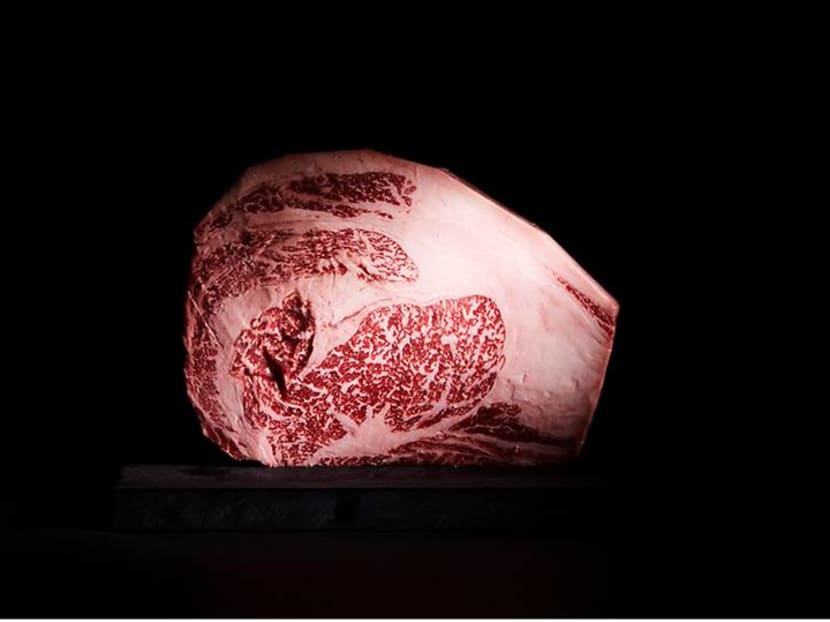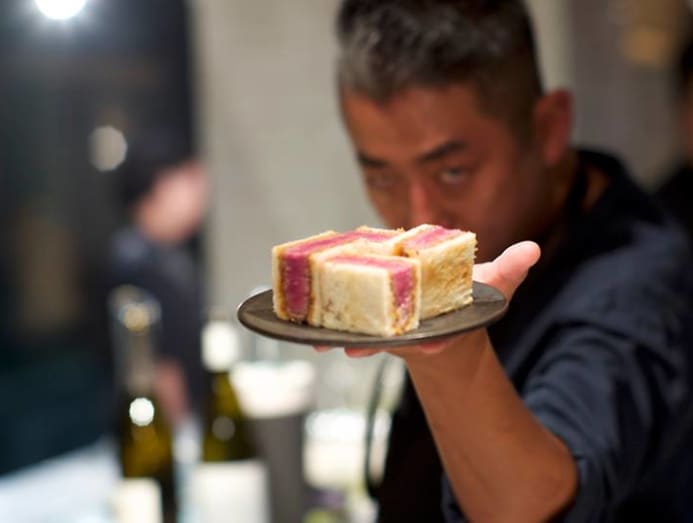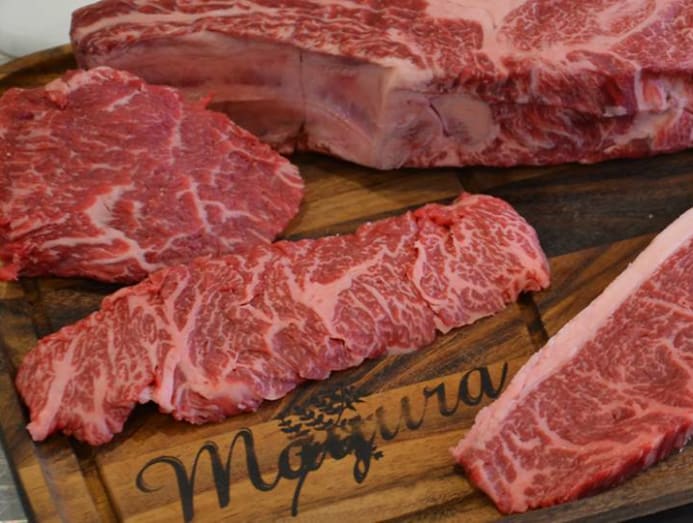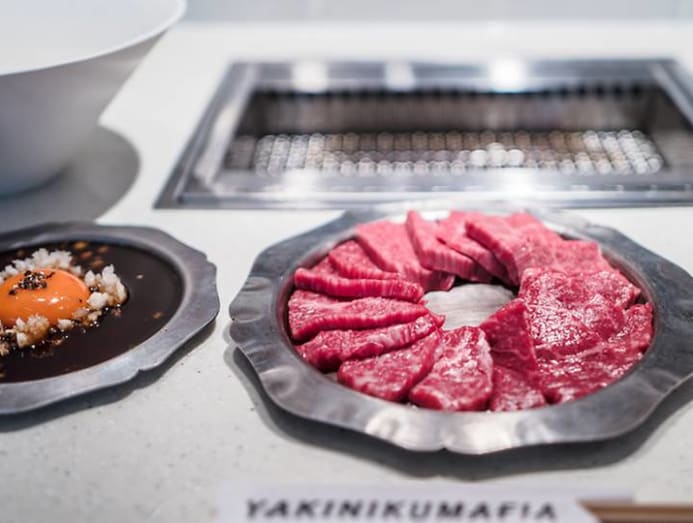In a city famous for pork and poultry, why are Hong Kongers eating so much beef?
Advertisement
Experiences
In a metropolis famous for pork and poultry, why are Hong Kongers eating so much beefiness?
Suppliers and restaurateurs say that strong need for beef, particularly wagyu, owes to its versatility and the inability of Hong Kong residents to travel to Japan.

In the 2022 survey of global beef consumption per head of population, Hong Kong came in third identify, with each citizen eating an amazing 51.7 kg of beef per year.
21 Jul 2022 06:30AM (Updated: 05 Jul 2022 01:30AM)
In the 2022 tabular array of global beef consumption per head of population, the countries in the top two spots were perhaps predictable: Argentina and Uruguay. They're famed for their beef production on vast ranches, as well as their history of cooking beef over asador grills.
In third identify, however, came Hong Kong, with each citizen eating an astonishing 51.vii kg of beef per year. That's the equivalent of almost two Big Macs per person, per day – every day.
READ> Meat-lovers guide: Where to indulge in the best dry-aged beef in Singapore
Beating countries similar the US and Australia is some feat, particularly when the SAR is better known for seafood consumption. All of which begs the questions of how and why beef has get such a huge part of the diet.
There are, of grade, sceptics who doubt the numbers. Some say that much of the beefiness is actually smuggled across the border to the Chinese mainland, where prices are higher and need greater.
But there's no doubting the overall trend in stratospheric growth in consumption: Back in 2001 when People's republic of china joined the Earth Trade Organization, the total value of its meat imports was only 15 per cent of the equivalent number in the US. Just 15 years afterward, however, they had already overtaken the U.S.

READ> Why are so many restaurants opening in Hong Kong? And why are they total?
Eating beef was in one case so rare in Prc that back in the 18th century, if yous looked for a recipe you'd notice it listed aslope palm civet and other "exotic" ingredients. But as Hong Kong's mail-war economy developed and living standards improved, it rapidly plant favour among local diners. A large expatriate population who were familiar with eating beef, not to mention the metropolis'south condition as a central global trading hub, both ensured that it grew in popularity to rival the traditionally virtually pop meat, pork.
There is no denying, however, that beef-eating habits have substantially evolved over the final few decades – and especially so in the last ten years. The city has seen a ascent in loftier-end beef specialists and standalone steak restaurants, leaving some famed traditional American steakhouse chains struggling to keep up.
Jason Lo is Manager of Waves Pacific, a company he founded in 2002 to supply the city's restaurants – and recently private customers – with high-stop produce, from truffles to caviar and some of the globe's finest beef, of which he sells betwixt eight to 10 tonnes per month.
"Hong Kong diners are now quite knowledgeable almost the origins of the beef, as people are well-travelled and have adult more sophisticated palates. But Hong Kong has always been a large beefiness city and information technology has greatly progressed in scope and diversity.
"Back when I started, the but 'premium' beef was from the U.s.a. and Japan. Australian beef was thought of as sub-standard. We spent the first few years irresolute that perception with Australian Wagyu beef, and today, Mayura Station and WX past Rangers Valley are our flagship brands."

With growing beef appreciation and noesis, so the variety of cuts on offer has grown.
"In one case nosotros got a foothold, we and so started to push the 'secondary cuts'," Lo added. "At the time, most restaurants only used the loin cuts such as striploins, ribeyes and tenderloins. When I was in Australia I tried the cheeks and decided to bring those in as well, and then i of the first secondary cuts we introduced was the Wagyu onglet. I remember bringing it to one of our early French clients and how excited he was."
Ultimately, Lo is bullish – excuse the pun – about the time to come of beef in Hong Kong.
He said: "The Hong Kong eatery marketplace is already quite crowded, but there is e'er room for someone to bring in something new and outgoing. Fifty-fifty with the rising of plant-based foods, demand has remained strong, mayhap because we work with producers who are mindful of the way they produce their beef.
"In all the hoopla, one of the things that gets lost is that quality meat is the production of high brute welfare and adept practices. Industrialised food production, whether it's meat or soy or anything, is something we all demand to be mindful of."

"Hong Kong people love loftier-end Japanese beef because wagyu is a brand like Rolex or eating caviar, so it's perceived as a luxury item. Information technology's specially popular now every bit people who would normally go to Japan to eat beef tin't travel, so they're looking for outlets to become their fix.
"We honey to educate people about the different types, how Miyazaki is dissimilar from Kagoshima, Kobe and Ozaki. At the same time we desire Yakinikumafia to introduce new diners to wagyu as at that place'south a new generation of producers and suppliers who want to bring it out to the world through more casual places."
His eating place group gets through more than than a tonne of beefiness a month, e'er imported fresh, never frozen, with prime and 2nd cuts distributed to dissimilar eateries. Dinner at Wagyumafia can run to HK$iv,000 per person (S$720) without drinks, but later on a very tough few months for the industry, business concern is back.
"Our consumption is higher than before and nosotros're one of the largest importers of Japanese wagyu. Information technology's both luxurious and scarce and then nosotros don't think appetite will get down. It'southward as well very versatile and that'south why customers keep coming back – nosotros fifty-fifty started a dim sum night featuring high-terminate wagyu in siu mai, baos, spring rolls and more."

Mario Paecke is Chef de Cuisine at SOMM at the Landmark Mandarin Oriental. One of his signature dishes is a beefiness tartare, only in line with the luxurious offerings across the five-star property, it is taken up a level.
"We all love a expert steak tartare, only information technology would be too obvious but to serve it the classical style. At SOMM, as at Amber, in that location will ever be a fiddling twist, so we apply the very best French techniques, amazing grass-fed beef from France by Alexandre Polmard seasoned with ingredients from Japan. The mild heat of the binchotan grilled dark-green chillies and the elegant fragrance of dark-green shiso are a perfect match without losing the flavour of the beef.
"The tartare is an elegant friction match with the huge varieties of wines & sakes past the drinking glass served in SOMM and you can get in various directions depending how adventurous yous are."

Equally to the key question regarding how beef compares in popularity with other meats on the menu, Paecke offered: "Beef remains very pop in Hong Kong and there'south no doubt it's the favourite meat in a poly peptide-heavy city. The taste of beefiness has evolved considerably over the years and is certainly more sophisticated.
"We too recognise that hunger for beef creates problems with the surround, hence we just focus on grass-fed beef and beef that has been ethically raised. We select the best possible choices that have less impact on our environment and are yet infrequent products."
Although non every restaurateur or consumer is as mindful of the bigger sustainability picture as Paecke, Lo and Li, with people like them leading the charge, it seems that beef still has a very bright future in the Fragrant Harbour.
"Beef remains very popular in Hong Kong and in that location's no doubt information technology's the favourite meat in a protein-heavy urban center." – Mario Paecke
Recent Searches
Trending Topics
Source: https://cnalifestyle.channelnewsasia.com/experiences/why-are-hong-kongers-eating-so-much-beef-247776

0 Response to "In a city famous for pork and poultry, why are Hong Kongers eating so much beef?"
Post a Comment